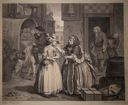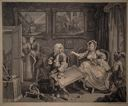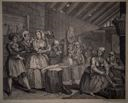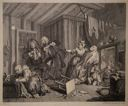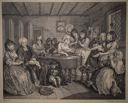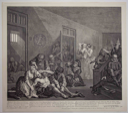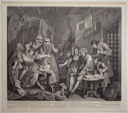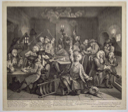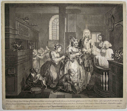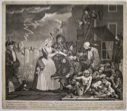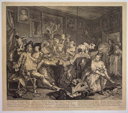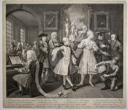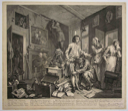William Hogarth
English
(London, England, 1697 - 1764)
William Hogarth was born in 1697 to Richard Hogarth and his wife Ann Gibbons Hogarth in the Bartholomew Close area of London. Richard Hogarth was the third son of a family of yeoman farmers who left his home at Kirkby Thore in the Vale of Bampton to become a schoolmaster, eventually setting up residence in London. William was Richard and Ann’s eldest child and only son. After he completed basic schooling under his father’s tutelage, he was apprenticed to a silver-plate engraver named Ellis Gamble, going to live with Gamble’s family near his shop, The Golden Angel, near Leicester Fields.
In autobiographical notes written later in life, Hogarth noted that from an early age he “had a naturally good eye, and a fondness for drawing.” (1) While his ability to draw offered the necessary advantages for his apprenticeship, he also noted that he found the business of silver engraving “in every respect too limited,” and would honor his commitment, but “no longer than necessity obliged.” (2) His artistic imagination and ambitions were stirred by the fresco paintings of the English artist James Thornhill (English, 1675–1734), who in the early decades of the 18th century was engaged in painting the dome of Sir Christopher Wren’s St. Paul’s Cathedral, and the Painted Hall at Greenwich Palace. As an Englishman, Thornhill’s success in the art arena was atypical; most prominent court painters at the time were immigrants from the Continent, and the Hanoverians who ruled England in the 18th century favored European artists over their English counterparts.
Hogarth first achieved artistic recognition as a designer and engraver of popular political and social commentary-themed broadsides that could be purchased very inexpensively in the 18th century. Initially he created works that were, as was a common practice in the period, pirated immediately by competing booksellers and print vendors. Resenting the loss of revenue that this represented, Hogarth began to publish his own engravings and thus preserved more of the proceeds for his own benefit. Further, he worked to master painting in oils. In March of 1729 he married James Thornhill’s daughter, Jane, and through that association began to improve his ability as a painter. In 1728–1729 he innovated a form of portraiture that is referred to as the “conversation piece.” That is, he inserted portraits of his client/sitters into informal group settings that mimic the appearance of figures in a stage-like setting, engaged in physical interaction or conversation.
As illustrated by this practice of incorporating of portraits of his contemporaries into his “conversation pieces,” Hogarth likewise was one of the first English painters to choose subjects suggested by contemporary events and the social climate in which he lived. His best-known engravings are set in the neighborhoods, gentlemen’s clubs, pubs, and, the public squares of Hogarth’s London. Most of the details seen in these compositions were derived from his own experience of the people and places around him, and many narratives were inspired by current events and newspaper accounts. Thus series such as A Harlot’s Progress, The Rake’s Progress, or Marriage a la Mode, for example, featured portraits of actual figures then well known in society—noblemen, justices, sheriffs, rogues, and well-known criminals—incorporated into their narratives.
Hogarth was one of the most successful engravers of contemporary topical prints, and, as a means of fully protecting his earnings from them, he drafted a bill to be placed before Parliament that would grant designers and engravers an exclusive right to their work for a period of 14 years from the time of publication. The bill was passed as the Copyright Act of 1735, and the King, then George III, assented on May 15, 1735. (3) The passage of the bill not only protected Hogarth’s income from his engraved work, but also that of others engaged in the publication of works in England. The market for such work expanded to the Continent, and it flourished, paving the way for others such as Alderman John Boydell (1719–1804), who supported his large publication projects such as Boydell's Graphic Illustrations of the Dramatic Works of Shakespeare almost solely through European sales until the French Revolution disrupted those markets.
As a successful artist, Hogarth took up the mantle of defender of English artists and English taste. He frequently satirized the pretentions of the English aristocracy who rejected the work of English artists in favor of those from France, Germany, or Italy. He found some success as a portraitist, however he was thwarted in his ambition to paint classical subjects in the manner of the Baroque artists, and his attempts were viciously criticized in the press. He published a treatise, The Analysis of Beauty, in 1753 in which he supported the rights of the artist at the expense of the patron, stating that the artist’s choice of subject and style should carry greater weight than that of a patron. His engravings made him a well-known figure in London society, and he frequented the clubs and literary organizations patronized by the intellectual middle class. Among his associates was the actor David Garrick, who maintained a close relationship with Hogarth until the artist’s death.
The artist’s final years were bitter in many ways. His memory failed, and the lack of appreciation for his paintings damaged his pride. His professional life was further shadowed by conflicts over the politics of the era, specifically his support for the government of the crown when it was largely unpopular with the public. The conflict was manifest in published broadsides of verse that vilified the artist, with the artist responding with engravings attacking his opponents. In failing health, the artist created his final engraving, The Bathos, published March 3, 1764 ,which he described as his “End of All Things.” The plate is surmounted the a title “The Tail Piece” which describes the content of the engraving: his world is shown as shattered and broken, and near a tavern sign post proclaiming “The World’s End” an exhausted figure of Time slumps with the blade of his scythe snapped off. He died at his home in Leicester Fields on October 25th, 1764.
1. Peter Quennell, Hogarth’s Progress, New York: Viking Press, 1955, p. 21.
2. Op. cit., p. 25.
3. Quennell, p. 126.
English
(London, England, 1697 - 1764)
William Hogarth was born in 1697 to Richard Hogarth and his wife Ann Gibbons Hogarth in the Bartholomew Close area of London. Richard Hogarth was the third son of a family of yeoman farmers who left his home at Kirkby Thore in the Vale of Bampton to become a schoolmaster, eventually setting up residence in London. William was Richard and Ann’s eldest child and only son. After he completed basic schooling under his father’s tutelage, he was apprenticed to a silver-plate engraver named Ellis Gamble, going to live with Gamble’s family near his shop, The Golden Angel, near Leicester Fields.
In autobiographical notes written later in life, Hogarth noted that from an early age he “had a naturally good eye, and a fondness for drawing.” (1) While his ability to draw offered the necessary advantages for his apprenticeship, he also noted that he found the business of silver engraving “in every respect too limited,” and would honor his commitment, but “no longer than necessity obliged.” (2) His artistic imagination and ambitions were stirred by the fresco paintings of the English artist James Thornhill (English, 1675–1734), who in the early decades of the 18th century was engaged in painting the dome of Sir Christopher Wren’s St. Paul’s Cathedral, and the Painted Hall at Greenwich Palace. As an Englishman, Thornhill’s success in the art arena was atypical; most prominent court painters at the time were immigrants from the Continent, and the Hanoverians who ruled England in the 18th century favored European artists over their English counterparts.
Hogarth first achieved artistic recognition as a designer and engraver of popular political and social commentary-themed broadsides that could be purchased very inexpensively in the 18th century. Initially he created works that were, as was a common practice in the period, pirated immediately by competing booksellers and print vendors. Resenting the loss of revenue that this represented, Hogarth began to publish his own engravings and thus preserved more of the proceeds for his own benefit. Further, he worked to master painting in oils. In March of 1729 he married James Thornhill’s daughter, Jane, and through that association began to improve his ability as a painter. In 1728–1729 he innovated a form of portraiture that is referred to as the “conversation piece.” That is, he inserted portraits of his client/sitters into informal group settings that mimic the appearance of figures in a stage-like setting, engaged in physical interaction or conversation.
As illustrated by this practice of incorporating of portraits of his contemporaries into his “conversation pieces,” Hogarth likewise was one of the first English painters to choose subjects suggested by contemporary events and the social climate in which he lived. His best-known engravings are set in the neighborhoods, gentlemen’s clubs, pubs, and, the public squares of Hogarth’s London. Most of the details seen in these compositions were derived from his own experience of the people and places around him, and many narratives were inspired by current events and newspaper accounts. Thus series such as A Harlot’s Progress, The Rake’s Progress, or Marriage a la Mode, for example, featured portraits of actual figures then well known in society—noblemen, justices, sheriffs, rogues, and well-known criminals—incorporated into their narratives.
Hogarth was one of the most successful engravers of contemporary topical prints, and, as a means of fully protecting his earnings from them, he drafted a bill to be placed before Parliament that would grant designers and engravers an exclusive right to their work for a period of 14 years from the time of publication. The bill was passed as the Copyright Act of 1735, and the King, then George III, assented on May 15, 1735. (3) The passage of the bill not only protected Hogarth’s income from his engraved work, but also that of others engaged in the publication of works in England. The market for such work expanded to the Continent, and it flourished, paving the way for others such as Alderman John Boydell (1719–1804), who supported his large publication projects such as Boydell's Graphic Illustrations of the Dramatic Works of Shakespeare almost solely through European sales until the French Revolution disrupted those markets.
As a successful artist, Hogarth took up the mantle of defender of English artists and English taste. He frequently satirized the pretentions of the English aristocracy who rejected the work of English artists in favor of those from France, Germany, or Italy. He found some success as a portraitist, however he was thwarted in his ambition to paint classical subjects in the manner of the Baroque artists, and his attempts were viciously criticized in the press. He published a treatise, The Analysis of Beauty, in 1753 in which he supported the rights of the artist at the expense of the patron, stating that the artist’s choice of subject and style should carry greater weight than that of a patron. His engravings made him a well-known figure in London society, and he frequented the clubs and literary organizations patronized by the intellectual middle class. Among his associates was the actor David Garrick, who maintained a close relationship with Hogarth until the artist’s death.
The artist’s final years were bitter in many ways. His memory failed, and the lack of appreciation for his paintings damaged his pride. His professional life was further shadowed by conflicts over the politics of the era, specifically his support for the government of the crown when it was largely unpopular with the public. The conflict was manifest in published broadsides of verse that vilified the artist, with the artist responding with engravings attacking his opponents. In failing health, the artist created his final engraving, The Bathos, published March 3, 1764 ,which he described as his “End of All Things.” The plate is surmounted the a title “The Tail Piece” which describes the content of the engraving: his world is shown as shattered and broken, and near a tavern sign post proclaiming “The World’s End” an exhausted figure of Time slumps with the blade of his scythe snapped off. He died at his home in Leicester Fields on October 25th, 1764.
1. Peter Quennell, Hogarth’s Progress, New York: Viking Press, 1955, p. 21.
2. Op. cit., p. 25.
3. Quennell, p. 126.
Artist Objects
